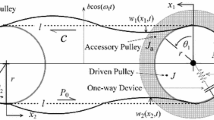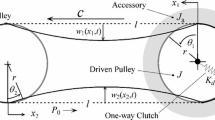Abstract
In this paper, we study the limit cycle of a nonlinear conveyor belt system by utilizing the perturbation incremental method. We first divide the system into two subclasses. On account of the former is heteroclinic orbit and the latter is not, there are some differences in the process of employing this method. Next two steps are introduced, the perturbation part provides the zero-order perturbation solution and takes it as the initial value of the incremental part, and in the incremental part, the corresponding limit cycle is obtained by controlling the value of the parameter \(\lambda \). Under this circumstance, approximate analytical expressions of limit cycles of those classes are found. Then, numerical simulations are presented to prove the effectiveness of the results by comparison with numerical integration using the fourth-order Runge–Kutta method. Finally, some conclusions and expectations are given.













Similar content being viewed by others
Availability of data and materials
The datasets used and/or analyzed during the current study are available from the corresponding author on reasonable request.
References
Vrande, V.D.B.B., Campen, V.D.D., Kraker, D.A.B.: Some aspects of the analysis of stick-slip vibrations with an application to drill strings, Asme Design Engineering Technical Conference: Detc. American Society of Mechanical Engineers (1997)
Lu, C.: Existence of slip and stick periodic motions in a non-smooth dynamical system. Chaos Solitons Fractals 35(5), 949–959 (2008)
Galvanetto, U., Bishop, S.R., Briseghella, L.: Mechanical stick-slip vibrations. Int. J. Bifurc. Chaos (2011)
Li, Q.H., Yan, Y.L., Wei, L.M., et al.: Complex bifurcations in a nonlinear system of moving belt. Acta Phys. Sinica 12, 73–82 (2013)
Yadav, O.P., Balaga, S.R., Vyas, N.S.: Forced vibrations of a spring-dashpot mechanism with dry friction and backlash, Int. J. Non-Linear Mech. (124) 103500 (2020)
Leine, R.I., Campen, D.H.V., Kraker, A.D., et al.: Stick-Slip Vibrations Induced by Alternate Friction Models. Nonlinear Dyn. 16(1), 41–54 (1998)
Stelter, K.P.: Stick-Slip vibrations and chaos. Philos. Trans. Phys. Sci. Eng. 332(1624), 89–105 (1990)
Luo, A.C.J., Huang, J.: Discontinuous dynamics of a non-linear, self-excited, friction-induced, periodically forced oscillator. Nonlinear Anal. Real World Appl. 13(1), 241–257 (2012)
Marques, F., Flores, P., Claro, J.P., et al.: A survey and comparison of several friction force models for dynamic analysis of multibody mechanical systems. Nonlinear Dyn. 86(3), 1407–1443 (2016)
Metrikin, V.S., Nagayev, R.F., Stepanova, V.V.: Periodic and stochastic self-excited oscillations in a system with hereditary-type dry friction. J. Appl. Math. Mech. 60(5), 845–850 (1996)
YegIldirek, A., Lewis, F.L.: Feedback linearization using neural networks. Automatica 31(11), 1659–1664 (1995)
Xu, Y., Ma, S., Zhang, H.: Hopf bifurcation control for stochastic dynamical system with nonlinear random feedback method. Nonlinear Dyn. 65(1), 77–84 (2010)
Wu, Y., Isidori, A., Lu, R., et al.: Performance recovery of dynamic feedback-linearization methods for multivariable nonlinear systems. IEEE Trans. Autom. Control 65(4), 1365–1380 (2020)
Nandakumar, K., Chatterjee, A.: Continuation of limit cycles near saddle homoclinic points using splines in phase space. Nonlinear Dyn. 57(3), 383–399 (2009)
Bagley, R.L., Torvik, P.J.: A theoretical basis for the application of fractional calculus to viscoelasticity. J. Rheol. 27(3), 201–210 (1983)
Suchorsky, M.K., Rand, R.H.: A pair of van der Pol oscillators coupled by fractional derivatives. Nonlinear Dyn. 69(1–2), 313–324 (2012)
Patnaik, S., Semperlotti, F.: Application of variable- and distributed-order fractional operators to the dynamic analysis of nonlinear oscillators. Nonlinear Dyn. 100(3), 1–20 (2020)
Patnaik, S., Hollkamp, J.P., Semperlotti, F.: Applications of variable-order fractional operators: a review. Proc. R. Soc. A Math. Phys. Eng. Sci. 476(2234), 20190498 (2020)
Zhang, H.T., Ding, Q.: Homotopy method for periodic solution of self-excited vibration of a dry-friction system. J. Vibr. Shock 08, 153–156 (2011)
Kim, W.J., Perkins, N.C.: Harmonic balance/Galerkin method for non-smooth dynamic systems. J. Sound Vibr. 261(2), 213–224 (2003)
Nandakumar, K., Chatterjee, A.: Higher-order Pseudoaveraging via harmonic balance for strongly nonlinear oscillations. J. Vibr. Acoust. 127(4), 416–419 (2005)
Ding, J., Ding, W.C., Li, D.Y.: Numerical computation of hopf bifurcation and limit cycles for nonlinear conveyor belt system. Mach. Design Manuf. 2, 107–109+113 (2019)
Chan, H.S.Y., Chung, K.W., Xu, Z.: A perturbation-incremental method for strongly non-linear oscillators. Int. J. Non-Linear Mech. 31(1), 59–72 (1996)
Chan, H.S.Y., Chung, K.W., Xu, Z.: Stability and bifurcations of limit cycles by the perturbation-incremental method. J. Sound Vibr. 206(4), 589–604 (1997)
Chen, S.H., Huang, W.L., Xu, Z.: Calculation of the semi-stable limit cycle of lineard equation. J. Sun Yat sen Univ. 37(6), 5–9 (1998)
Xu, Z., Chen, S.H.: Calculation of limit cycles and homoclinic (heteroclinic) orbits of strongly nonlinear oscillators. J. Nonlinear Dyn. Eng. 4(4), 303–311 (1997)
Cao, Y.Y.: The perturbation-incremental method for nonlinear dynamical systems, City University of Hong Kong (2012)
Qin, B.W.: A study of homoclinic/Heteroclinic bifurcations, homoclinic-doubling bifurcations and cascades of dynamical systems using a perturbation-incremental method, City University of Hong Kong (2017)
Chen, S.H., Huang, C.B., Xu, Z.: Calculation of limit cycles for a class of plane differential equations. J. Sun Yat sen Univ. 39(3), 1–5 (2000)
Xu, Z., Chen, S.H., Huang, W.L.: Expression and calculation of limit cycle. Acta Mathematicae Applicatae Sinica 4, 612–621 (2003)
Chen, C.L.: A perturbation-incremental (PI) method for strongly non-linear oscillators and systems of delay differential equations, City University of Hong Kong (2005)
Wang, H.: Analytical solutions and bifurcation of nonlinear oscillators with discontinuities and impulsive systems by a perturbation-incremental method, City University of Hong Kong (2012)
Acknowledgements
The authors gratefully acknowledge the financial supports by the National Natural Science Foundation of China (Nos.11701163, 11561022, 11901437) and Foundation for Technological Base and Talents of Guangxi, China (Nos.GuiKeAD20159028).
Funding
This work was supported by the National Natural Science Foundation of China (Nos.11701163, 11561022, 11901437) and Foundation for Technological Base and Talents of Guangxi, China (Nos.Gui KeAD20159028).
Author information
Authors and Affiliations
Corresponding authors
Ethics declarations
Conflict of interests
The authors declare that they have no competing interests.
Ethics approval and consent to participate
The research in this paper does not involve any ethical research.
Consent for publication
All authors agree to publish this paper.
Additional information
Publisher's Note
Springer Nature remains neutral with regard to jurisdictional claims in published maps and institutional affiliations.
Appendices
Appendix A
Appendix B
where
for \(k<0\), \(\zeta _{1,k}=\eta _{1,k}=\gamma _{3,k}=\delta _{3,k}=0\).
Appendix C
Appendix D
where
for \(k<0\), \(\zeta _{1,k}=\eta _{1,k}=r_{4,k}=\delta _{4,k}=0\).
Rights and permissions
About this article
Cite this article
Wang, H., Chen, Z., Li, Z. et al. Perturbation incremental method of limit cycle for a nonlinear conveyor belt system. Nonlinear Dyn 104, 3533–3545 (2021). https://doi.org/10.1007/s11071-021-06573-2
Received:
Accepted:
Published:
Issue Date:
DOI: https://doi.org/10.1007/s11071-021-06573-2




